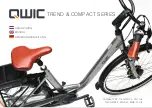
12
Chapter 4: Safety
The manual has detailed safety riding methods. In this chapter we will further discuss additional safety guidelines.
a)
The basics
Below is a safety guideline according to the CPSC (US Consumer Product Safety Commission) in regards to riding a bike.
Always wear a
helmet to help prevent head injuries.
Observe all traffic laws and signals, just as automobiles must do.
Don’t ride double or attempt stunts.
Ride near the curb in the same direction as traffic.
Find alternate routes, rather than ride through busy intersections and heavy or high-speed traffic.
Walk -- don't ride -- your bicycle across busy intersections and left turn corners.
Avoid riding in wet weather. When wet, handbrakes may require a long distance to stop.
Avoid riding in the dark. If you do, be sure the bike is equipped with a headlight, a taillight and reflectors.
Apply retro-reflective trim to clothing, or wear reflective vests and jackets.
Avoid loose clothing or long coats that can catch in pedals or wheels. Leg clips or bands keep pants legs
from tangling in the chain.
Avoid crossing raised sewer grates.
Regular maintenance is essential for safe riding. Refer to the maintenance recommendations. If you do not
have basic mechanical skills, an authorized dealer should perform repairs and maintenance.
Align (or "true") wobbly wheels for better control. Spokes also may need adjustment.
Replace all missing, damaged, or worn parts; for example, brake pads, chainguards, chain links, spokes,
screws and bolts, handlebar grips.
Tighten and/or adjust loose parts.
Periodically inspect frame, fork, spindles and other components for cracking.
Parts should be adjusted to manufacturer's torque specifications.
Inflate tires to recommended pressure, and replace worn tires.
Lightly oil and clean moving parts. Keep oil off rubber.
Keep bicycle indoors when not in use.
b)
Riding Safety
Below are guidelines according to the NHSTA (National Highway and Traffic Safety Administration) on bicycle safety.
Protect Your Head: Wear a Helmet -
Never ride a bicycle without wearing a properly fitted helmet. Helmets are
proven to be 85-88 percent effective in preventing traumatic brain injury, the primary cause of death and disabling
injuries resulting from cycling crashes. Wear a helmet that meets the U.S. Consumer Product Safety Commission
(CPSC) standard (see inside of helmet for presence of a label).
Assure Bicycle Readiness: Ensure Proper Size and Function of Bicycle -
Make sure the bicycle fits you: Stand
over the top of the Outlaw bicycle
– there should be minimum 3 inches of clearance from the frame bar. Seat height —
as previously mentioned, with the ball of your foot on the pedal, the fully extended leg should have a slight bend.
Check all parts of the bicycle to make sure they are secure and working well: The Handlebar should be firmly in place
and turns easily. The wheels must be straight and secure; the quick release rear axle must be secured.
Stop It: Always Check Brakes Before Riding -
Always control your speed by using your brakes. Apply the rear
brake slightly before the front brake. Always keep your brakes adjusted. If you cannot stop quickly, adjust your brakes.
Review Chapter 7 ―Maintenance and Replacement‖ section c ―Brake adjustments‖ to adjust the brakes. When your
hand brake levers are fully applied, they should not touch the handlebars. Ride slowly in wet weather and apply your
brakes earlier, it takes more distance to stop.
See and Be Seen -
Wear clothes that make you more visible. Always wear neon, florescent, or other bright colors
when riding a bicycle.
Avoid Biking at Night -
It is far more dangerous to ride a bicycle at night than during the day. The Outlaw requires
LED lights for night time riding. If you must ride at night, you should also do the following: wear retro-reflective clothing
or material, not just white or florescent, especially on your ankles, wrists, back, and helmet. Only ride in areas familiar
to you. Brightly lit streets are best. Always assume you are not seen by a driver. Children should NOT ride at night.
Go With the Flow: The Safe Way is the RIGHT Way -
Ride on the right side in a straight, predictable path. Always
go single file in the same direction as other vehicles. Riding against traffic puts you where motorists don't expect you.
They may not see you, and may pull across your path, or turn into you.
Check for Traffic: Always Be Aware of the Traffic Around You -
Over 70 percent of car-bicycle crashes occur at
driveways or other intersections. Before you enter any street or intersection, check for traffic. Always look left-right-left,
and walk your bicycle into the street to begin your ride. If you are already in the street, always look behind you for a
break-in traffic, then signal before going left or right. Watch for left or right turning traffic.













































